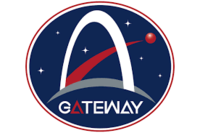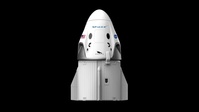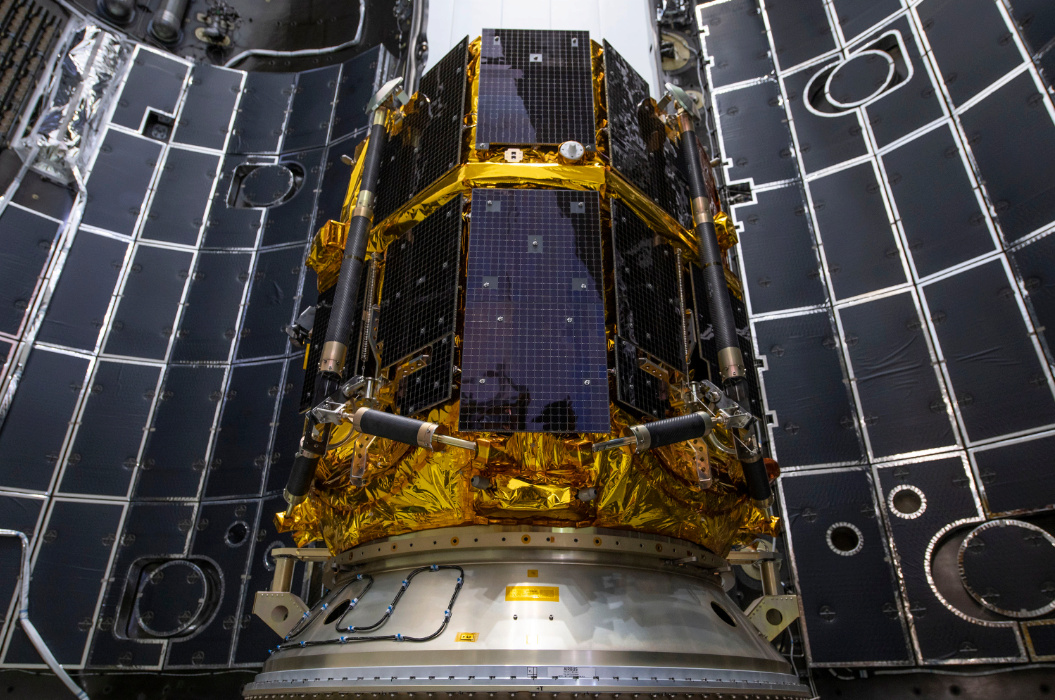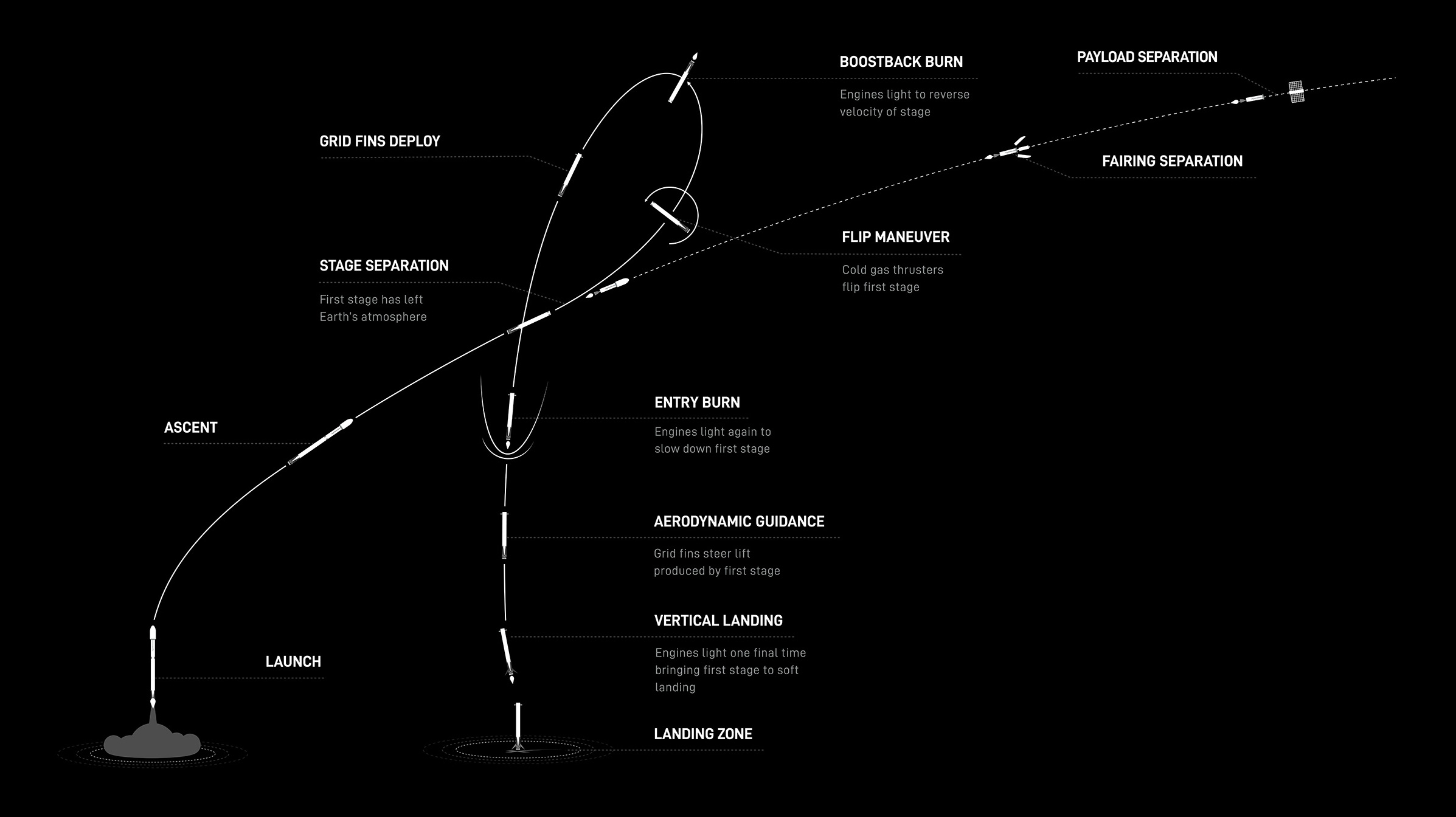Falcon 9 (Hakuto-R1 et Rashid) - KSC - 11.12.2022
Page 1 sur 2
Page 1 sur 2 • 1, 2 
Ouverture du sujet dédié au lancement par une Falcon 9 de Hakuto-R1 et Rashid.
Le programme Hakuto-R prévoie deux missions : un atterrisseur Hakuto-R1 (mission 1) lancé en novembre 2022 qui vise à valider la technologie et à préparer la mission 2 d'exploration avec un rover.
L'atterrisseur Hakuto R-1 intègre le rover Rashid des Emirats Arabes Unis. D'une masse de 10 kg, il mesure 53,5 cm de long pour une hauteur de 53,85 cm.
Le programme Hakuto-R prévoie deux missions : un atterrisseur Hakuto-R1 (mission 1) lancé en novembre 2022 qui vise à valider la technologie et à préparer la mission 2 d'exploration avec un rover.
L'atterrisseur Hakuto R-1 intègre le rover Rashid des Emirats Arabes Unis. D'une masse de 10 kg, il mesure 53,5 cm de long pour une hauteur de 53,85 cm.
_________________
Blog sur le suivi du développement d'Orion
HAKUTO-R est un programme multinational d'exploration lunaire commerciale exploité par ispace.
Il comprend deux missions lunaires et la première effectuera un atterrissage en douceur sur la Lune en 2022. Ce sera la première mission japonaise dirigée par le secteur privé à atterrir sur la surface lunaire.
Le sujet sur la génèse de la mission et son suivi se trouve ici : https://www.forum-conquete-spatiale.fr/t21709-japon-hakuto-r-atterrisseur-lunaire-2022#top
Il comprend deux missions lunaires et la première effectuera un atterrissage en douceur sur la Lune en 2022. Ce sera la première mission japonaise dirigée par le secteur privé à atterrir sur la surface lunaire.
Le sujet sur la génèse de la mission et son suivi se trouve ici : https://www.forum-conquete-spatiale.fr/t21709-japon-hakuto-r-atterrisseur-lunaire-2022#top
_________________
Blog sur le suivi du développement d'Orion
Lunar Flashlight sera embarqué sur cet atterrisseur, et plus sur la mission IM-1.
NASA’s Lunar Flashlight Ready to Search for the Moon’s Water Ice
Oct 28, 2022
Set for a November launch, the small satellite mission will use lasers to search for water ice inside the darkest craters at the Moon’s South Pole.
The Moon’s poles offer a tantalizing opportunity for human explorers: There may be reservoirs of water ice there that could be purified as drinking water, converted into breathable oxygen, and used as fuel by astronauts. These reservoirs are inside permanently shadowed craters – regions where the Sun never rises above crater rims.
It’s known that water ice exists below the lunar regolith (broken rock and dust), but scientists don’t yet understand whether surface ice frost covers the floors inside these cold craters. To find out, NASA is sending Lunar Flashlight, a small satellite (or SmallSat) no larger than a briefcase. Swooping low over the lunar South Pole, it will use lasers to shed light on these dark craters – much like a prospector looking for hidden treasure by shining a flashlight into a cave. The mission will launch aboard a SpaceX Falcon 9 rocket in mid-November.
“This launch will put the satellite on a trajectory that will take about three months to reach its science orbit,” said John Baker, the mission’s project manager at NASA’s Jet Propulsion Laboratory in Southern California. “Then Lunar Flashlight will try to find water ice on the surface of the Moon in places that nobody else has been able to look.”
Fuel-Efficient Orbits
After launch, mission navigators will guide the spacecraft way past the Moon. It will then be slowly pulled back by gravity from Earth and the Sun before it settles into a wide, looping, science-gathering orbit. This near-rectilinear halo orbit will take it 42,000 miles (70,000 kilometers) from the Moon at its most distant point and, at its closest approach, the satellite will graze the surface of the Moon, coming within 9 miles (15 kilometers) above the lunar South Pole.
SmallSats carry a limited amount of propellent, so fuel-intensive orbits aren’t possible. A near-rectilinear halo orbit requires far less fuel than traditional orbits, and Lunar Flashlight will be only the second NASA mission to use this type of trajectory. The first is NASA’s Cislunar Autonomous Positioning System Technology Operations and Navigation Experiment (CAPSTONE) mission, which will arrive at its orbit on Nov. 13, making its closest pass over the Moon’s North Pole.
“The reason for this orbit is to be able to come in close enough that Lunar Flashlight can shine its lasers and get a good return from the surface, but to also have a stable orbit that consumes little fuel,” said Barbara Cohen, Lunar Flashlight principal investigator at NASA’s Goddard Space Flight Center in Greenbelt, Maryland.
As a technology demonstration, Lunar Flashlight will be the first interplanetary spacecraft to use a new kind of “green” propellant that is safer to transport and store than the commonly used in-space propellants such as hydrazine. This new propellant, developed by the Air Force Research Laboratory and tested on a previous NASA technology demonstration mission, burns via a catalyst, rather than requiring a separate oxidizer. That is why it’s called a monopropellant. The satellite’s propulsion system was developed and built by NASA’s Marshall Space Flight Center in Huntsville, Alabama, with integration support from Georgia Tech Research Institute in Atlanta.
Lunar Flashlight will also be the first mission to use a four-laser reflectometer to look for water ice on the Moon. The reflectometer works by using near-infrared wavelengths that are readily absorbed by water to identify ice on the surface. Should the lasers hit bare rock, their light will reflect back to the spacecraft, signaling a lack of ice. But if the light is absorbed, it would mean these dark pockets do indeed contain ice. The greater the absorption, the more ice may be at the surface.
Lunar Water Cycle
It’s thought that molecules of water come from comet and asteroid material impacting the lunar surface, and from solar wind interactions with the lunar regolith. Over time, the molecules may have accumulated as a layer of ice inside “cold traps”.
“We are going to make definitive surface water ice measurements in permanently shadowed regions for the first time,” said Cohen. “We will be able to correlate Lunar Flashlight’s observations with other lunar missions to understand how extensive that water is and whether it could be used as a resource by future explorers.”
Cohen and her science team hope that the data Lunar Flashlight gathers can be used to understand how volatile molecules, like water, cycle from location to location and where they may accumulate, forming a layer of ice in these cold traps.
“This is an exciting time for lunar exploration. The launch of Lunar Flashlight, along with the many small satellite missions aboard Artemis I, may form the foundations for science discoveries as well as support future missions to the Moon’s surface,” said Roger Hunter, Small Spacecraft Technology program manager at NASA’s Ames Research Center in California’s Silicon Valley.
More About the Mission
In October, Lunar Flashlight was fueled at NASA’s Marshall Space Flight Center in Huntsville, Alabama, and is scheduled to launch aboard a SpaceX Falcon 9 rocket from Cape Canaveral Space Force Station in Florida between Nov. 9 and 15 with the Japanese Hakuto-R lander and United Arab Emirate’s Rashid 1 rover. The mission worked with Maverick Space Systems to provide launch integration services.
NASA’s Small Business Innovation Research program funded component development from small businesses including Plasma Processes Inc. (Rubicon) for thruster development, Flight Works for pump development, and Beehive Aerospace (formerly Volunteer Aerospace) for specific 3D printed components. The Air Force Research Laboratory also contributed financially to the development of the Lunar Flashlight propulsion system.
Lunar Flashlight will be operated by Georgia Tech, including graduate and undergraduate students. The mission is funded by the Small Spacecraft Technology program within NASA’s Space Technology Mission Directorate.
Ian J. O’Neill
Jet Propulsion Laboratory, Pasadena, Calif.
818-354-2649
ian.j.oneill@jpl.nasa.gov
2022-166
Last Updated: Oct 28, 2022
Editor: Naomi Hartono
https://www.nasa.gov/feature/jpl/nasa-s-lunar-flashlight-ready-to-search-for-the-moon-s-water-ice
NASA’s Lunar Flashlight Ready to Search for the Moon’s Water Ice
Oct 28, 2022
Set for a November launch, the small satellite mission will use lasers to search for water ice inside the darkest craters at the Moon’s South Pole.
The Moon’s poles offer a tantalizing opportunity for human explorers: There may be reservoirs of water ice there that could be purified as drinking water, converted into breathable oxygen, and used as fuel by astronauts. These reservoirs are inside permanently shadowed craters – regions where the Sun never rises above crater rims.
It’s known that water ice exists below the lunar regolith (broken rock and dust), but scientists don’t yet understand whether surface ice frost covers the floors inside these cold craters. To find out, NASA is sending Lunar Flashlight, a small satellite (or SmallSat) no larger than a briefcase. Swooping low over the lunar South Pole, it will use lasers to shed light on these dark craters – much like a prospector looking for hidden treasure by shining a flashlight into a cave. The mission will launch aboard a SpaceX Falcon 9 rocket in mid-November.
“This launch will put the satellite on a trajectory that will take about three months to reach its science orbit,” said John Baker, the mission’s project manager at NASA’s Jet Propulsion Laboratory in Southern California. “Then Lunar Flashlight will try to find water ice on the surface of the Moon in places that nobody else has been able to look.”
Fuel-Efficient Orbits
After launch, mission navigators will guide the spacecraft way past the Moon. It will then be slowly pulled back by gravity from Earth and the Sun before it settles into a wide, looping, science-gathering orbit. This near-rectilinear halo orbit will take it 42,000 miles (70,000 kilometers) from the Moon at its most distant point and, at its closest approach, the satellite will graze the surface of the Moon, coming within 9 miles (15 kilometers) above the lunar South Pole.
SmallSats carry a limited amount of propellent, so fuel-intensive orbits aren’t possible. A near-rectilinear halo orbit requires far less fuel than traditional orbits, and Lunar Flashlight will be only the second NASA mission to use this type of trajectory. The first is NASA’s Cislunar Autonomous Positioning System Technology Operations and Navigation Experiment (CAPSTONE) mission, which will arrive at its orbit on Nov. 13, making its closest pass over the Moon’s North Pole.
“The reason for this orbit is to be able to come in close enough that Lunar Flashlight can shine its lasers and get a good return from the surface, but to also have a stable orbit that consumes little fuel,” said Barbara Cohen, Lunar Flashlight principal investigator at NASA’s Goddard Space Flight Center in Greenbelt, Maryland.
As a technology demonstration, Lunar Flashlight will be the first interplanetary spacecraft to use a new kind of “green” propellant that is safer to transport and store than the commonly used in-space propellants such as hydrazine. This new propellant, developed by the Air Force Research Laboratory and tested on a previous NASA technology demonstration mission, burns via a catalyst, rather than requiring a separate oxidizer. That is why it’s called a monopropellant. The satellite’s propulsion system was developed and built by NASA’s Marshall Space Flight Center in Huntsville, Alabama, with integration support from Georgia Tech Research Institute in Atlanta.
Lunar Flashlight will also be the first mission to use a four-laser reflectometer to look for water ice on the Moon. The reflectometer works by using near-infrared wavelengths that are readily absorbed by water to identify ice on the surface. Should the lasers hit bare rock, their light will reflect back to the spacecraft, signaling a lack of ice. But if the light is absorbed, it would mean these dark pockets do indeed contain ice. The greater the absorption, the more ice may be at the surface.
Lunar Water Cycle
It’s thought that molecules of water come from comet and asteroid material impacting the lunar surface, and from solar wind interactions with the lunar regolith. Over time, the molecules may have accumulated as a layer of ice inside “cold traps”.
“We are going to make definitive surface water ice measurements in permanently shadowed regions for the first time,” said Cohen. “We will be able to correlate Lunar Flashlight’s observations with other lunar missions to understand how extensive that water is and whether it could be used as a resource by future explorers.”
Cohen and her science team hope that the data Lunar Flashlight gathers can be used to understand how volatile molecules, like water, cycle from location to location and where they may accumulate, forming a layer of ice in these cold traps.
“This is an exciting time for lunar exploration. The launch of Lunar Flashlight, along with the many small satellite missions aboard Artemis I, may form the foundations for science discoveries as well as support future missions to the Moon’s surface,” said Roger Hunter, Small Spacecraft Technology program manager at NASA’s Ames Research Center in California’s Silicon Valley.
More About the Mission
In October, Lunar Flashlight was fueled at NASA’s Marshall Space Flight Center in Huntsville, Alabama, and is scheduled to launch aboard a SpaceX Falcon 9 rocket from Cape Canaveral Space Force Station in Florida between Nov. 9 and 15 with the Japanese Hakuto-R lander and United Arab Emirate’s Rashid 1 rover. The mission worked with Maverick Space Systems to provide launch integration services.
NASA’s Small Business Innovation Research program funded component development from small businesses including Plasma Processes Inc. (Rubicon) for thruster development, Flight Works for pump development, and Beehive Aerospace (formerly Volunteer Aerospace) for specific 3D printed components. The Air Force Research Laboratory also contributed financially to the development of the Lunar Flashlight propulsion system.
Lunar Flashlight will be operated by Georgia Tech, including graduate and undergraduate students. The mission is funded by the Small Spacecraft Technology program within NASA’s Space Technology Mission Directorate.
Ian J. O’Neill
Jet Propulsion Laboratory, Pasadena, Calif.
818-354-2649
ian.j.oneill@jpl.nasa.gov
2022-166
Last Updated: Oct 28, 2022
Editor: Naomi Hartono
https://www.nasa.gov/feature/jpl/nasa-s-lunar-flashlight-ready-to-search-for-the-moon-s-water-ice

bean_kenobi- Donateur

- Messages : 552
Inscrit le : 05/03/2010
Age : 46
Localisation : Dans l'espace
As a technology demonstration, Lunar Flashlight will be the first interplanetary spacecraft to use a new kind of “green” propellant that is safer to transport and store than the commonly used in-space propellants such as hydrazine. This new propellant, developed by the Air Force Research Laboratory and tested on a previous NASA technology demonstration mission, burns via a catalyst, rather than requiring a separate oxidizer. That is why it’s called a monopropellant. The satellite’s propulsion system was developed and built by NASA’s Marshall Space Flight Center in Huntsville, Alabama, with integration support from Georgia Tech Research Institute in Atlanta.
On n'en connait pas plus sur cet ergol (monopropellant) miracle et surtout "green".
Donc si on ne connait pas ce qui se forme après passage sur le catalyseur .... il faut les croire sur parole

Cela dit pour une mission lunaire ... donc lointaine ..... une expérimentation ..... doit bien se faire quelque part.
On verra si c'est suffisamment performant et non polluant, donc utilisable ultérieurement pour un atterrisseur lunaire, martien ou sur une comète par exemple.

montmein69- Donateur

- Messages : 20962
Inscrit le : 01/10/2005
Age : 73
Localisation : région lyonnaise
Le lancement est déormais prévu le 22 novembre 2022.
https://twitter.com/CanadaInSpace/status/1587124156642037763
https://twitter.com/CanadaInSpace/status/1587124156642037763

David L.- Modérateur

- Messages : 34773
Inscrit le : 16/08/2009
Age : 51
Localisation : Troisième planète
Selon un article publié cette semaine sur le site du CNES, l'agence a fournit 3 caméras CASPEX pour le rover Rashid.
Il s'agit des premiers instruments "français" envoyés sur la Lune depuis 50 ans.
Ces mêmes caméras ont, en revanche, été utilisées sur une centaine de sats Oneweb, sur Perseverance, sur Eyesat et équipera bientôt la mission MMX qui doit se poser sur Phobos.
Il s'agit des premiers instruments "français" envoyés sur la Lune depuis 50 ans.
Ces mêmes caméras ont, en revanche, été utilisées sur une centaine de sats Oneweb, sur Perseverance, sur Eyesat et équipera bientôt la mission MMX qui doit se poser sur Phobos.

Fabien- Messages : 6862
Inscrit le : 23/09/2005
Age : 46
Localisation : Paris (75)
Dernière édition par Wakka le Mar 29 Nov 2022 - 11:12, édité 2 fois
_________________
Blog sur le suivi du développement d'Orion
SpaceX :
"Après de nouvelles inspections du lanceur et un examen des données, nous nous retirons du lancement de la mission prévue le 1er décembre. Une nouvelle date de lancement cible sera donnée une fois celle-ci confirmée.
"Après de nouvelles inspections du lanceur et un examen des données, nous nous retirons du lancement de la mission prévue le 1er décembre. Une nouvelle date de lancement cible sera donnée une fois celle-ci confirmée.
_________________
Blog sur le suivi du développement d'Orion
La Falcon va même retourner dans son hangar... Le problème à l'origine du retard concerne le lanceur.
Et c'est le deuxième problème sur la Falcon 9 en moins de deux semaines, avec l'annulation du lancement de sats Starlink le 18 novembre (Starlink 2-4), de Vandenberg.
Et c'est le deuxième problème sur la Falcon 9 en moins de deux semaines, avec l'annulation du lancement de sats Starlink le 18 novembre (Starlink 2-4), de Vandenberg.
_________________
Blog sur le suivi du développement d'Orion
Lancement le 6/12 à 22h37 UTC. Booster 1073,5e vol et retour en LZ-2

AlexSSC- Messages : 2222
Inscrit le : 22/02/2020
Age : 26
Localisation : Lyon
Astro-notes a écrit:Wakka spécialiste des annonces des retards, reports, repoussages à une date ultérieure ; Zoiseau de mauvaise augures va ...
J'y suis pour rien ! pas taper !

_________________
Blog sur le suivi du développement d'Orion
Wakka a écrit:Astro-notes a écrit:Wakka spécialiste des annonces des retards, reports, repoussages à une date ultérieure ; Zoiseau de mauvaise augures va ...
J'y suis pour rien ! pas taper !
Ce n'est pas un Jedi qui s'aventurera à taper un Seigneur Sith


bean_kenobi- Donateur

- Messages : 552
Inscrit le : 05/03/2010
Age : 46
Localisation : Dans l'espace
Page 1 sur 2 • 1, 2 
 Sujets similaires
Sujets similaires» [EAU] [Rashid] Rover lunaire (Génèse et suivi de mission) - 2022
» Falcon 9 (Hakuto-R M2 Resilience et Tenacious) - KSC/CCSFS - Décembre 2024
» Falcon 9 (Dragon CRS-26) - KSC - 26.11.2022
» Falcon 9 (Dragon CRS-25) - KSC - 15.7.2022
» Falcon 9 (Starlink 4-26) - KSC - 10.8.2022
» Falcon 9 (Hakuto-R M2 Resilience et Tenacious) - KSC/CCSFS - Décembre 2024
» Falcon 9 (Dragon CRS-26) - KSC - 26.11.2022
» Falcon 9 (Dragon CRS-25) - KSC - 15.7.2022
» Falcon 9 (Starlink 4-26) - KSC - 10.8.2022
Page 1 sur 2
Permission de ce forum:
Vous ne pouvez pas répondre aux sujets dans ce forum
 Portail
Portail



 Sam 15 Oct 2022 - 18:55
Sam 15 Oct 2022 - 18:55







